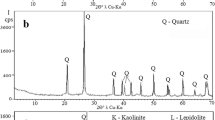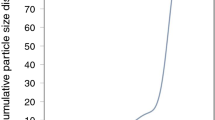Abstract
The present work proposes the manufacture of ceramic construction materials using raw materials which are only industrial wastes from different production processes (electric arc furnace steel slag, coal bottom ash, carbon fly ash, and oil-filtering diatomaceous-earth). From them, the SiO2-Al2O3-CaO equilibrium phase diagram has been used to formulate two materials compositions with the objective of obtaining ceramics whose chemical composition is located in the same area as a traditional clay-based material, but with two different technological behaviors: refractoriness due to calcium phase’s development and densification due to a greater melting capacity. The waste-based pieces have been sintered at three firing temperatures (1000 °C, 1050 °C, and 1100 °C) and the mineralogical composition has been quantified by Rietveld refinement-XRD in order to establish the agreement between the phases foreseen by the formulations in the diagrams and the mineralogical compositions actually developed after the sintering treatment. In addition, fired materials have been subjected to a complete microstructural characterization by means of SEM-EDX and the pore size distribution has been determined by means of mercury intrusion porosimetry and helium pycnometry. In general, all obtained materials display adequate technological properties for their use as building materials so this characterization has allowed to show the suitability of the ternary diagram SiO2-Al2O3-CaO for the design of ceramic compositions from industrial wastes. Therefore, extending the use of phase diagrams as a design tool is still little explored for waste-based ceramics, and those that have been mainly used for studying Mg-based phases can have an important contribution to a more sustainable construction sector.






Similar content being viewed by others
References
Ahmaruzzaman MA (2010) Review on the utilization of fly ash. Program Energy Combust 36:327–363. https://doi.org/10.1016/j.pecs.2009.11.003
Aineto M, Acosta A, Rincón JM, Romero M (2006) The slag from ELCOGAS IGCC thermal power plant as raw material for the synthesis of glass-ceramic materials. Part 2: synthesis and characterization of the glass-ceramic materials. Bol Soc Esp Ceram Vidrio 45(1):28–32
Alaa AS, Naganathan S, Nasharuddin K, Mustapha (2013) Properties of bricks made using fly ash, quarry dust and billet scale. Constr Build Mater 41:131–138. https://doi.org/10.1016/j.conbuildmat.2012.11.077
Andreola F, Barbieri L, Lancellotti I, Pozzi P (2005) Recycling industrial waste in brick manufacturing. Part 1. Mater Constr 55(280):5–16. https://doi.org/10.3989/mc.2005.v55.i280.202
Aşkın A, Tatar I, Kılınç S, Tezel O (2017) The utilization of waste magnesite in the production of the cordierite ceramic. Energy Procedia 107:137–143. https://doi.org/10.1016/j.egypro.2016.12.151
Barbieri L, Andreola F, Lancellotti I, Taurino R (2013) Management of agricultural biomass wastes: preliminary study on characterization and valorisation in clay matrix bricks. Waste Manag 33(11):2307–2315. https://doi.org/10.1016/j.wasman.2013.03.014
Baruzzo D, Minichelli D, Bruckner S, Fedrizzi L, Bachiorrini A, Maschio S (2006) Possible production of ceramic tiles from marine dredging spoils alone and mixed with other waste materials. J Hazard Mater B 134:202–210. https://doi.org/10.1016/j.jhazmat.2005.10.053
Chen Y, Zhang Y, Chen T, Zhao Y, Bao S (2011) Preparation of eco-friendly construction bricks from hematite tailings. Constr Build Mater 25:2107–2111. https://doi.org/10.1016/j.conbuildmat.2010.11.025
Chou M, Patel V, Laird CJ, Ho KK (2001) Chemical and engineering properties of fired bricks containing 50 weight per cent of class F fly ash. Energy Sources 23:665–673. https://doi.org/10.1080/00908310119850
Chumachenko NG, Tyurnikov VV, Petrova EV (2016) Controlled process of liquid-phase sintering due to low-fusible melt forming. Procedia Eng 153:118–123. https://doi.org/10.1016/j.proeng.2016.08.090
De Aza AH, Pena P, Caballero A, Dd Aza S (2011) The phase equilibrium diagrams as a tool for the design and use of refractories. Bol Soc Esp Ceram Vidrio 50(6):279–290. https://doi.org/10.3989/cyv.372011
Demir I (2008) Effect of organic residues addition on the technological properties of clay bricks. Waste Manag 28:622–627. https://doi.org/10.1016/j.wasman.2007.03.019
Eliche-Quesada D, Corpas-Iglesias FA, Pérez-Villarejo L, Iglesias-Godino FJ (2012) Recycling of sawdust, spent earth from oil filtration, compost and marble residues for brick manufacturing. Constr Build Mater 34:275–284. https://doi.org/10.1016/j.conbuildmat.2012.02.079
El-Mahhllwy MS (2008) Characteristics of acid resisteng bricks made from quarry residues and waste steel slag. Constr Build Mater 22:1887–1896. https://doi.org/10.1016/j.conbuildmat.2007.04.007
Environmental management systems - Guidelines for incorporating ecodesign (ISO 14006:2011)
Fabbri B, Dondi M (1995) Caratteristiche e difetti del laterizio. Gruppo Editoriale Faenza Editrice S.p.A. Faenza
Favoni C, Minichelli D, Tubaro F, Brückner S, Bachiorrini A, Maschio S (2005) Ceramic processing of municipal sewage sludge (MSS) and steelworks slags (SS). Ceram Int 31:697–702. https://doi.org/10.1016/j.ceramint.2004.07.010
Feng HE, Fang Y, Xie J, Xie J (2012) Fabrication and characterization of glass–ceramics materials developed from steel slag waste. Mater Des 42:198–203. https://doi.org/10.1016/j.matdes.2012.05.033
Fiori C, Fabbri B, Donati F, Venturi I (1989) Mineralogical composition of the clay bodies used in the Italian tile industry. Appl Clay Sci 4(5–6):461–473. https://doi.org/10.1016/0169-1317(89)90023-9
Galán-Arboledas RJ (2014) End of Master Project: Development of a new hydraulic binder from marl from the Province of Jaén. University of Jaén, Jaén October 2014
Galán-Arboledas RJ, Bueno S (2016) Production of ceramic materials using only waste as raw materials. Key Eng Mater 663:62–71. https://doi.org/10.4028/www.scientific.net/KEM.663.62
Galán-Arboledas RJ, Merino A, Bueno S (2013) Use of new raw materials and industrial wastes to improve the possibilities of using ceramic materials from Bailén (Jaén, southern Spain). Mater Constr 63(312):553–568. https://doi.org/10.3989/mc.2012.03412
Galán-Arboledas RJ, Cotes T, Martínez C, Bueno S (2015) Influence of waste addition on the porosity of clay based ceramic membranes. Desalin Water Treat 57:2633–2639. https://doi.org/10.1080/19443994.2015.1017011
Galán-Arboledas RJ, Álvarez de Diego J, Dondi MB (2017) S. Energetic, environmental and technical assessment for the incorporation of waste steel slag in ceramic building materials. J Clean Prod 142:1778–1788. https://doi.org/10.1016/j.jclepro.2016.11.110
Gencel O, Sutcu M, Erdogmus E, Koc V, Cay VV, Gok MS (2013) Properties of bricks with waste ferrochromium slag and zeolite. J Clean Prod 59:111–119. https://doi.org/10.1016/j.jclepro.2013.06.055
González I, Galán E, Miras A, Aparicio P (1998) New uses for brick-making clay materials from the Bailén area (southern Spain). Clay Miner 33(3):453–465. https://doi.org/10.1180/000985598545750
Hadjar H, Hamdi B, Jaber M, Brendlé J, Kessaïssia Z, Balard H, Donnet JB (2008) Elaboration and characterization of new mesoporous materials from diatomite and charcoal. Microporous Mesoporous Mater 107:219–226. https://doi.org/10.1016/j.micromeso.2007.01.053
Horizon (2020) https://ec.europa.eu/programmes/horizon2020/en/h2020-section/climate-action-environment-resource-efficiency-and-raw-materials. Accesed 26 March 2019
Kavouras P, Kehagias T, Tsilika I, Kaimakamis G, Chrissafis K, Kokkou S, Papadopoulos D, Karakostas T (2007) Glass-ceramic materials from electric arc furnace dust. J Hazard Mater 139:424–429. https://doi.org/10.1016/j.jhazmat.2006.02.043
Kockal NU (2012) Utilisation of different types of coal fly ash in the production of ceramic tiles. Bol Soc Esp Ceram Vidrio 51(5):297–304. https://doi.org/10.1016/j.matdes.2011.06.046
Kute S, Deodhar SV (2003) Effect of fly ash and temperature on properties of burnt clay bricks. J Civil Eng 84:82–85
Lihua Z, Li Y, Zhou Y, Cang D (2014) Preparation of novel ceramics with high CaO content from steel slag. Mater Des 64:608–613. https://doi.org/10.1016/j.matdes.2014.08.015
Lin KL, Lan JY (2013) Water retention characteristics of porous ceramics produced from waste diatomite and coal fly ash. J Clean Energy Technol 1(3):211–215. https://doi.org/10.7763/JOCET.2013.V1.48
Lingling X, Wei G, Tao W, Nanru Y (2005) Study on fired bricks with replacing clay by fly ash in high volume ratio. Constr Build Mater 9:243–247. https://doi.org/10.1016/j.conbuildmat.2004.05.017
Menendez E et al (2013) Characterization of bottom ashes from coal pulverized power plants to determine their potential use feasibility. Bol Soc Esp Ceram Vidrio 52(6):296–304. https://doi.org/10.3989/cyv.372013
Monteiro SN, Vieira CMF (2005) Effect of oily waste addition to clay ceramic. Ceram Int 31(2):353–358. https://doi.org/10.1016/j.ceramint.2004.05.002
Mymrine V, Ponte MJJS, Ponte HA, Kaminari NMS, Pawlowsky U, Solyon GJP (2013) Oily diatomite and galvanic wastes as raw materials for red ceramics fabrication. Constr Build Mater 41:360–364. https://doi.org/10.1016/j.conbuildmat.2012.11.041
Pai-Haung S, Wu Z-Z, Chiang H-L (2004) Characteristics of bricks made from waste steel slag. Waste Manag 24:1043–1047. https://doi.org/10.1016/j.wasman.2004.08.006
Pei D, Li Y, Cang D (2017) Na+-solidification behavior of SiO2-Al2O3-CaO-MgO (10 wt%) ceramics prepared from red mud. Ceram Int 43(18):16936–16942. https://doi.org/10.1016/j.ceramint.2017.09.098
Ponsot I, Bernardo E (2013) Self-glazed glass ceramic foams from metallurgical slag and recycled glass. J Clean Prod 59:245–250. https://doi.org/10.1016/j.jclepro.2013.06.029
Queralt I, Querol X, Lopez-Soler A (1997) Plana, F. Use of coal fly ash for ceramics. Fuel 76(8):787–791
Raut SP, Ralegaonklar RV, Mandavgane SA (2011) Development of sustainable construction material using industrial and agricultural solid waste: a review of waste-create bricks. Constr Build Mater 25:4037–4042. https://doi.org/10.1016/j.conbuildmat.2011.04.038
Romero M, Rincón JM (2000) The controlled vitrification/crystallisation process applied to the recycling of inorganic industrial wastes. Bol Soc Esp Ceram Vidrio 39(1):155–163
Serra MF, Acebedo MF, Conconi MS, Suarez G, Aglietti EF, Rendtorff NM (2014) Thermal evolution of the mechanical properties of calcareous earthware. Ceram Int 40:1709–1716. https://doi.org/10.1016/j.ceramint.2013.07.067
Shiau JS, Liu SH, Ho CK (2012) Effect of magnesium and aluminum oxides on fluidity of final blast furnace slag and its application. Mater Trans JIM 53(8):1449–1455
Vinai R, Lawane A, Minane JR, Amadou A (2013) Coal combustion residues valorisation: research and development on compressed brick production. Constr Build Mater 40:1088–1096. https://doi.org/10.1016/j.conbuildmat.2012.11.096
Yu-Ling W et al (2013) Recycling steel-manufacturing slag and harbor sediment into construction materials. J Hazard Mater 265:253–260. https://doi.org/10.1016/j.jhazmat.2013.11.049
Zhang L (2013) Production of brick from waste materials—a review. Constr Build Mater 47:643–655. https://doi.org/10.1016/j.conbuildmat.2013.05.043
Zhenzi J, Hirotaka M, Ioku K, Ishida E (2007) Hydrothermal synthesis of mesoporous materials from diatomaceous earth. Mater Interfaces Electrochem Phenomena 53(8):2114–2122. https://doi.org/10.1002/aic.11235
Zhu Q, Wang H, Tian Y, Gao R, Zhao S, Huang L, Xu S, Zhang Z (2017) The forming region and mechanical properties of CaO-Al2O3-SiO2 system. Ceram Int 43(16):13810–13816. https://doi.org/10.1016/j.ceramint.2017.07.101
Acknowledgements
The technical and human support provided by CICT of Universidad de Jaén (UJA, MINECO, Junta de Andalucía, FEDER) is gratefully acknowledged. The support from the EFIWALL Project (PI12/1920, Junta de Andalucía) is also acknowledged.
Funding
This work was funded by the SMARTMATS Project, (MAT2015-70034-R, Spanish Ministry of Economy and Competitiveness).
Author information
Authors and Affiliations
Corresponding author
Additional information
Responsible editor: Philippe Garrigues
Publisher’s note
Springer Nature remains neutral with regard to jurisdictional claims in published maps and institutional affiliations.
Rights and permissions
About this article
Cite this article
Galán-Arboledas, R.J., Cotes-Palomino, M.T., Martínez-García, C. et al. Ternary diagrams as a tool for developing ceramic materials from waste: relationship between technological properties and microstructure. Environ Sci Pollut Res 26, 35574–35587 (2019). https://doi.org/10.1007/s11356-019-05343-3
Received:
Accepted:
Published:
Issue Date:
DOI: https://doi.org/10.1007/s11356-019-05343-3




